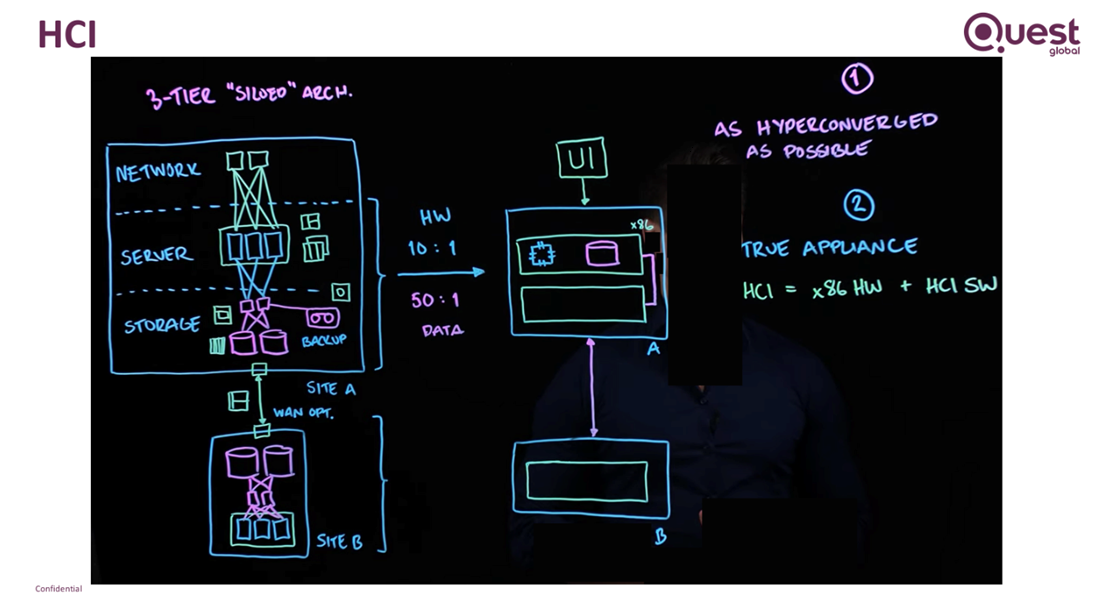In the ever-changing world of technology, the systems that hold our data and run our applications have undergone major changes. Traditional data center infrastructure, which used to be the backbone of organizational IT, is now facing challenges to stay relevant. The rise of Hyper-converged Infrastructure (HCI) marks a new phase, showcasing a significant change in the way businesses view and manage their IT infrastructure.
The transition from hardware-defined to software-defined architecture is a hallmark of the accelerated adoption of HCI. In a hardware-defined model, the infrastructure is often rigid, with physical hardware at its core dictating the capabilities and limitations of the system. Conversely, a software-defined architecture, embodied by HCI, abstracts and virtualizes the underlying hardware, allowing for a more flexible, manageable, and scalable infrastructure.
HCI is available as both physical hardware and managed services. This shift creates a scenario where businesses are not held back by the common limitations of traditional data centers like security compliance issues and challenges with working across multiple vendors. HCI also makes it easier for enterprises to adopt hybrid and private cloud solutions, providing a break from previous infrastructure limitations.
The conventional three-tiered data center architecture segregates networking, storage, and computing into distinct tiers, often leading to increased complexity and reduced flexibility. Traditional data centers often grapple with a myriad of challenges such as adhering to stringent security compliance standards and navigating the complexities of multivendor collaboration. The lack of a unified management platform and the rigidity of the infrastructure further exacerbate the hurdles enterprises face in a traditional data center setup. On the other hand, HCI unifies these tiers into a single, integrated infrastructure. This consolidation facilitates simplified management, enhanced scalability, and faster deployments, providing a stark contrast to the rigid and siloed nature of traditional data center architectures.
HCI presents itself in two main options for enterprises: as physical hardware or as managed services. The hardware aspect encompasses an integrated appliance that houses the compute, storage, and networking components, while the managed services aspect offers a virtualized solution managed by service providers. Both forms embody the principle of simplified, centralized management, albeit delivered in different modalities to cater to varying organizational needs.

HCI plays a pivotal role in enabling both hybrid and private cloud architectures within enterprises, thereby aligning IT infrastructure with modern business demands. The streamlined nature of HCI provides a robust foundation for deploying cloud services seamlessly. Hybrid cloud configurations, which combine on-premises, private cloud, and third-party public cloud services, become notably more manageable and efficient with HCI. Similarly, private cloud deployments, which demand a high degree of security and control, benefit from HCI’s integrated and secure architecture. The agility and simplified management of HCI facilitate easier cloud transitions, allowing enterprises to optimize resource allocation, enhance data mobility, and ensure consistent performance across the cloud spectrum.
Enterprises often face real-world challenges such as operational inefficiencies, data silos, and the cumbersome task of managing disparate systems in traditional data center setups. Additionally, the evolving threat landscape and the need for stringent compliance adherence add layers of complexity. HCI emerges as a solution by amalgamating compute, storage, and networking resources into a unified, software-driven infrastructure. This consolidation addresses the issue of data silos and promotes operational efficiency by simplifying management tasks through centralized interfaces. Moreover, HCI's inherent design facilitates enhanced security and compliance management, providing a framework that can be easily monitored, managed, and adjusted to meet the dynamic needs of enterprises. Through its integrated and agile architecture, HCI alleviates many of the challenges associated with traditional data centers, paving the way for a more responsive and resilient IT infrastructure.
In the modern digital ecosystem, diverse applications necessitate varied computational capabilities. GPU (Graphics Processing Unit) acceleration has emerged as a salient feature to cater to these disparate compute demands. GPUs, with their parallel processing capabilities, significantly bolster the computational power of HCI, thereby facilitating the smooth execution of graphics-intensive and high-performance computing tasks. Applications pertaining to machine learning, artificial intelligence, data analytics, and graphical rendering greatly benefit from GPU acceleration. Incorporating GPU capabilities within HCI augments the infrastructure to meet the rigorous computational demands of these specialized applications, rendering a high-performance, agile environment conducive to advanced data processing and analytics. NVMe (Non-Volatile Memory Express) technology is a quintessential component that significantly enhances the storage performance within HCI. Unlike traditional storage interfaces, NVMe is designed to capitalize on the capabilities of modern solid-state drives (SSDs), offering lower latency and higher throughput. In the context of HCI, NVMe technology amplifies the performance by providing faster data access and processing capabilities. The integration of NVMe within HCI aligns with the overarching objective of delivering a high-performance, scalable, and efficient infrastructure. The confluence of GPU acceleration and NVMe technology in HCI illustrates a concerted effort to address the specialized computational and storage requisites of modern enterprises. Through the integration of these advanced technologies, HCI transcends traditional infrastructure limitations, offering a compelling solution capable of accommodating the diverse and demanding computational needs of contemporary applications.
HCI’s inherent design promoting consolidated, efficient, and agile infrastructure finds specific use cases across various industry verticals.
⦁ Healthcare:
⦁ The healthcare sector is filled with data-intensive operations ranging from electronic health records (EHR) management to medical imaging and diagnostics. HCI facilitates seamless data management, quick access to critical patient information, and ensures high availability, which is crucial for life-saving decisions. Additionally, the robust security features of HCI are instrumental in adhering to stringent healthcare compliance standards like HIPAA.
⦁ Financial:
⦁ In the financial domain, the need for real-time data processing, high availability, and uncompromising data security is critical. HCI caters to these demands by offering a high-performance, scalable, and secure infrastructure. It enables financial institutions to swiftly process large volumes of transactional data, manage risk analytics, and ensure continuous service availability, all while adhering to regulatory compliance.
⦁ Industrial Engineering:
⦁ The industrial sector, characterized by its diverse operational environments, necessitates an infrastructure that is resilient, scalable, and capable of handling varied workloads. HCI, with its streamlined deployment and centralized management, proves to be a viable solution for industrial applications like manufacturing process control, supply chain management, and predictive maintenance. Its scalable nature allows for the seamless integration of emerging technologies like IoT and AI, which are pivotal in driving industrial automation and innovation.
In the expanding landscape of HCI, various hardware vendors have specialized themselves, offering their unique blend of HCI solutions tailored to meet the nuanced demands of modern enterprises.
⦁ Dell Technologies: Dell's HCI solutions, spearheaded by their VxRail and PowerFlex offerings, encapsulate a seamless integration of compute, storage, and networking resources. These solutions are promoted for their robustness, ease of deployment, and comprehensive management features.
⦁ Hewlett Packard Enterprise (HPE): HPE’s HCI solutions, particularly through their SimpliVity and Nimble dHCI offerings, excel in delivering high performance and data efficiency. HPE’s HCI portfolio is designed to simplify operations, enhance performance, and ensure resiliency.
⦁ Cisco: Cisco's HyperFlex HCI solution extends the agility of data center core to the edges, powered by a robust networking backbone. Its architectural flexibility and operational simplicity make it a viable choice for enterprises aiming for a unified, cloud-ready infrastructure.
⦁ VMware: VMware’s vSAN forms the cornerstone of its HCI offering, delivering a software-defined storage solution integrated with its industry-leading vSphere hypervisor and vCenter management suite. VMware HCI is often chosen for its ease of management, scalability, and deep integration with the broader VMware ecosystem.
Each vendor offers a unique proposition, yet the common thread binding them is the promise of a simplified, scalable, and performance-oriented HCI solution that aligns with the evolving enterprise infrastructure demands.
Quest Global, with its extensive expertise and a client-centric approach, has helped our engineering clients embrace the paradigm of Hyper-converged Infrastructure (HCI), through services that assist customers in navigating the complex landscape of HCI management. Our services encompass a holistic range from initial deployment, seamless integration with existing systems, to continuous monitoring and optimization. Our HCI experts ensures that the transition to and management of HCI is smooth, efficient, and yields tangible benefits for your business. In addition to managing HCI deployments, Quest Global has been at the forefront of developing innovative applications tailored to harness the full potential of Hyper-converged Infrastructure. These applications span across various domains including, but not limited to, real-time data analytics, machine learning, and process automation. Similarly, in the healthcare domain, their applications facilitate seamless management and analysis of large volumes of patient data, ensuring swift and accurate diagnostics and treatment plans.
Our focus is on not merely deploying HCI but ensuring it morphs into a vital cog in our client’s operational efficiency, delivering enhanced performance, scalability, and a robust security. Through a fusion of deep technical expertise, industry insights, and a thorough understanding of HCI dynamics, Quest Global stands as a reliable partner for enterprises embarking on or optimizing their HCI journey.

Director - Technology and Center Of Excellence Leader (Cloud),
Quest Global